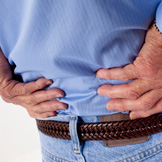
You don’t have to live through many winters in Wisconsin to know they are long! Despite living most of my life here, I never seem to get used to it – in fact as I get older (and I’m sure I’m not alone in this sentiment) I think I’m less tolerant of winter weather! It’s no wonder once Daylight Saving Time hits and the hours of usable daylight increase, followed by consistent temperatures above 50 degrees, that Wisconsinites emerge in droves out of hibernation in a seeming frenzy to recapture nature, deferred fitness, and a host of yard or home maintenance projects. Whether its resumption of outdoor boot camp fitness classes, getting back on the bike, hitting outdoor running trails, or participation in any one of many competitive outdoor racing events, sprains and strains are not uncommon and serve as a frequent cause of visits to an orthopedic surgeon’s office each spring.
Home Improvement Projects
As a spine specialist, while sports-related back injuries occur, the most common cause of injuries in spring are those related to home improvement and maintenance projects. Whether it’s cleaning out and organizing the garage, climbing up and down ladders to clean windows or gutters, moving outdoor furniture out of storage, or a laundry list of gardening and landscaping projects, a common theme of repetitive bending, lifting, pushing and pulling type activities abounds. These activities often follow a long winter of inactivity and deconditioning of the body where the core and paraspinal muscles become out of balance. The core is integral in protecting the spine which degenerates as a normal consequence of aging. Spinal muscles that are out of balance or weak, when subjected to repetitive activities or loads in the absence of stretching and conditioning exercises, can become strained and go into spasm. Sudden or severe, debilitating back pain in the absence of leg pain or neurologic changes is often related to muscle spasms. Thankfully, these episodes are often self-limited and will resolve with activity limitation/ relative rest, anti-inflammatory medication, ice, heat, or topical analgesics. Severe pain or activity restriction of more than two to three days should be evaluated by a spine specialist to adjust medications, perform a thorough physical exam, and likely refer for physical therapy.
Injury Prevention
Self-directed prevention strategies include a slow and progressive approach to outdoor work and activities; special attention to body mechanics, posture, ergonomics, and lifting techniques; getting assistance with lifting heavy or awkward objects; hiring out projects that require more intense and respective lifting, bending and twisting type actions; adopting a workout routine such as Yoga or Pilates that emphasizes stretching and core strengthening.
More Information
If you’re suffering from a back injury, turn to the experts at Midwest Orthopedic Specialty Hospital.